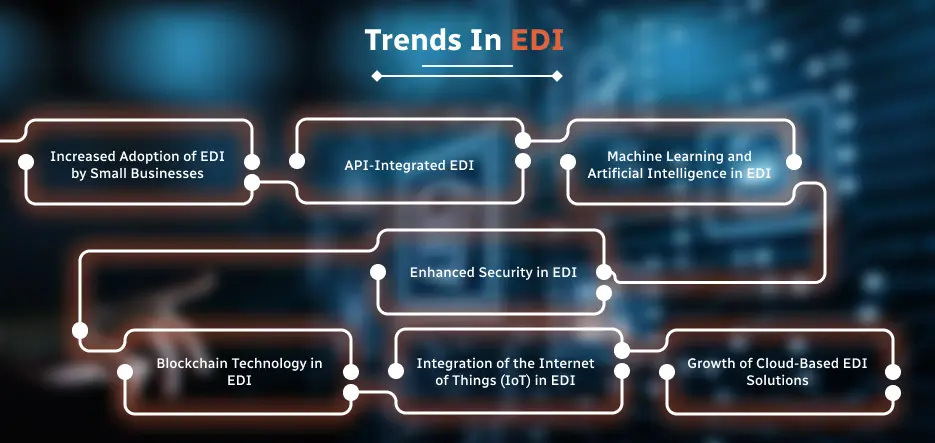EDI stands for Electronic Data Interchange, structuring the electronic exchange of key business documents from vendor to supplier and trading partner. All supply chain participants need to communicate data, and traditional EDI systems have been available for a long time. When it came to manual B2B communications, including email and fax, Cloud-based EDI was a huge advance. It is possible to send thousands of common business documents automatically and directly between systems, for example, from a supplier’s internal system to a seller’s system. Because cloud-based EDI solutions are widely used in the industry and are easy to extract data from business systems, companies are still choosing them. According to a recent Forrester report, EDI transactions surpass $20 billion annually and are expected to increase from 20% in 2022 to 21% in 2027. Many incompatible APIs are more difficult to connect to legacy systems than EDI.
Regrettably, traditional EDI solutions may be costly, particularly for smaller companies. These are on-premises solutions, therefore initial software and hardware investments are necessary. To prevent costly equipment updates, they need to know the maximum capacity you might demand in the future. They also call for the hiring of more employees and the possession of specialized knowledge. When on-premises solutions are not adequately maintained, they might result in expensive security breaches due to their outdated security measures.
Thankfully, more recent cloud-based options are available. Because cloud-based EDI is more flexible and responsive to changing technical infrastructure, it is starting to replace traditional techniques. The definition of cloud EDI systems, their advantages over conventional EDI techniques, and the reasons behind the widespread use of Cloud-based EDI are all covered in this article.
What are Cloud EDI solutions?
Web-based EDI, also known as Cloud-based EDI is an EDI system that uses the cloud as opposed to internal data servers. To use Cloud-based EDI, businesses require:
- An EDI solutions provider: Businesses must work with EDI service providers to use EDI in the cloud. The servers and network required to run web-based EDI as well as IT support to guarantee seamless message flow are provided by an EDI provider.
- Web-based EDI Translator: An online EDI translator is used by businesses to prepare EDI transactions under their demands.
- A network: Secure networks for sending and receiving EDI transactions are necessary for web-based EDI solutions. Value Added Networks (VANs) and Single Channel Networks are two types of networks used for EDI transactions. However, Single Channel Networks make it challenging to extend across many sales channels, and VANs necessitate human document processing. Numerous businesses opt for a multi-enterprise commerce network, which offers a single worldwide network linking thousands of trading partners.
Seamless Transition from Traditional to Cloud EDI
There is a solid reason why there is a lot of discussion about corporate activities getting a switch to cloud EDI. Most important, however, is the scalability brought by cloud computing, which allows firms to scale up or down based on demand. Security for data is provided through cloud apps; they cut down on money spent on hardware and maintenance and allow the use of apps from any place that has a working internet connection.
Through cloud EDI, companies may make use of these common cloud-hosted advantages while still being able to communicate with their trading partners online and exchange structured data. Cloud services can be customized and are adaptable. expanding your company? Without requiring you to maintain your servers or a large IT team to operate the hardware and software, cloud EDI grows and adapts to your company. To your advantage, your outsourced cloud partner takes care of these duties.
It doesn’t have to be difficult to switch from traditional systems to cloud-based EDI. Contemporary cloud EDI technologies streamline operations for EDI integration and onboarding, making it simple to replicate current systems in the cloud. Purchase orders, invoices, and receipts are just a few of the business documents that are formatted by Cloud-based EDI solutions using the same standardized electronic forms that you are accustomed to, like ANSI X12 in the US, UN/EDIFACT internationally, and XML. Next, it uses secure communication protocols like SFTP, HTTPS, or AS2 to transfer the documents.

The Key Benefits of Cloud-Based EDI Solutions
Organizations can now use cloud-based EDI solutions thanks to the development of cloud technology. Many advantages are provided by this, including scalability, accessibility, and teamwork. Let’s examine the many benefits of cloud-based EDI systems in more detail.
Scalability: Managing Business Expansion
Probably, one major strength of EDI migration based in the cloud has to do with flexibility for scaling. The cloud architecture will help you easily scale your EDI operations to meet growing needs as your organization grows. Scaling out on-premise EDI will involve buying more hardware, acquiring software licensing, and increasing the IT staff. Cloud-based EDI removes these restrictions, allowing you to scale up or down your operations willfully in line with your company requirements.
You can effortlessly manage variations in transaction volumes without suffering from a decline in performance by utilizing cloud infrastructure. Cloud-based EDI can easily meet the increasing needs, whether you have abrupt spikes during peak seasons or need to handle a bigger amount of transactions because your organization is growing. Therefore, continuous data exchange with your trading partners is guaranteed by cloud-based EDI.
Availability: Everywhere, at Any Time Interaction
When considering accessibility, Cloud-based EDI software is more favorable than on-premise options. When using on-premise EDI, data management and access may be limited to a single physical location or necessitate intricate remote access configurations. On the other hand, authorized users can securely access EDI-managed services with cloud-based EDI from any location with an internet connection.
Global trading partners, remote teams, and enterprises with multiple locations would all benefit greatly from this accessibility. Regardless of location, cloud-based EDI provides real-time collaboration and expedites decision-making. Additionally, workers’ responsiveness and productivity are increased since they can simply access EDI data from a variety of devices, such as computers, tablets, and smartphones.
Streamlined Partner Connectivity for Collaboration
EDI services that are hosted on the cloud enable smooth communication and cooperation with trading partners. Custom configurations and individual connections for every trading partner are common requirements for traditional on-premise EDI, which adds complexity and demands time-consuming maintenance. On the other hand, centralized hubs provided by cloud-based EDI technologies make trading partner onboarding and management easier.
EDI platforms that are cloud-based usually offer pre-configured connections to well-known trading networks. This makes it simple for you to connect with a wide range of partners. This facilitates a quicker time-to-value, expedites the partner onboarding process, and shortens the implementation period. In addition, a lot of Cloud-based EDI solutions come with extensive partner management tools like analytics, self-service portals, and monitoring, which promote effective teamwork and reduce the need for manual intervention.
Savings: Lower Maintenance and Infrastructure
On-premise EDI infrastructure implementation and upkeep can be costly. It necessitates large upfront expenditures for IT resources, software licenses, and hardware. Furthermore, continuous upkeep, enhancements, and assistance amplify the overall cost of ownership.
Implementing EDI lowers ongoing maintenance expenses and does away with the requirement for initial infrastructure investments. With cloud-based solutions, you subscribe to the services you use and pay for them accordingly. This enables you to match expenses to your real EDI needs. Furthermore, by relieving the strain on internal IT resources, cloud-based EDI allows your team to concentrate on strategic goals instead of maintaining and debugging EDI infrastructure.
Strong Protection and Data Governance for Security and Compliance
Every EDI deployment must take security and compliance into account. Advanced security measures at the cloud EDI providers involve firewalls, access limits, and data encryption to ensure that sensitive information does not go out of the company. Their professional teams monitor all security threats and work to protect your data from all kinds of dangers.
In addition, cloud EDI providers frequently go through periodic security assessments and certifications to adhere to industry standards and laws like PCI-DSS, GDPR, and HIPAA. You can make sure that your EDI activities comply with compliance requirements without having to worry about handling intricate security regulations on your own by utilizing their experience and strong security safeguards.
Offers Benefits of Cloud Computing
Cloud computing hosts an EDI system. Once again, it permits the user to reduce the capital cost associated with buying and maintaining hardware, since the cost is a running expense to the company in trying to be competitive in technology, which keeps on advancing. Thus, in achieving its advantage, cloud computing eliminates the need for a company ever upgrade and buy software consistently, as this exercise is taken care of by the outside partner.
A cloud-based EDI solution also lessens the requirement for large IT personnel to oversee a wide range of servers and software to support the solution. Because cloud-based partners that service numerous clients are required to uphold the most recent data protection measures, cloud data has also been shown to be more secure than on-premises data. To guarantee that crucial data is constantly accessible, the cloud also offers a reliable business continuity/disaster recovery data protection solution.
Reduce staff workload using cloud-based EDI.
Your IT staff might not have the necessary specialized skills to operate EDI management systems, and maintaining optimal performance requires a lot of daily duties. This frequently entails having to pay for pricey training, recruit more IT staff, and have your IT staff devote more time to other crucial or more strategically important tasks for your company.
By implementing a cloud-based EDI solution, your company may save money on personnel expenses and free up your IT team’s time and resources to work on other important projects. You can obtain highly skilled and proficient professionals right now.
Is Cloud EDI for Everybody?
Businesses worldwide depend on EDI systems for the exchange of B2B documents. Whether it is with their trading partners, clients, suppliers, vendors, or any other entities. One of the major reasons behind opting for Cloud-based EDI software is that it provides one single standard for communicating with every entity of interest within the corporate ecosystem. All business verticals are adopting EDI more and more, but the traditional EDI solutions that businesses rely on to exchange B2B documents are growing more rigid and constrictive. This means that businesses need to handle additional governance, onboarding, and data transformation processes, which slows down business processes overall. This is why a growing number of companies are seeking advanced Cloud EDI solutions that bring much more flexibility than legacy EDI systems.
On the other hand, cloud EDI is more appropriate for small and medium-sized businesses in the light of its low cost, ease of use, and no necessity for complicated installations of software, with no previous EDI experience. Current digital transformation is obliging many small- and medium-sized firms to make use of cloud-based solutions, including Internet EDI, which can be reached from any part of the world using only a laptop and an Internet connection. In addition, Cloud EDI provides a blend of technology and business process enhancements tailored to satisfy the needs of the current market.
Applications of Cloud EDI
Cloud EDI solutions handle automation, and data transformation, and resolve any issues with integration without requiring you to install and maintain hardware and software.
Businesses require contemporary EDI capabilities in today’s hyper-digital business environment to handle B2B document exchange between suppliers, vendors, trading partners, and more. Many companies lack sufficient knowledge about EDI technology and the difficulties in integrating it into the supply chain. This is the reason why a lot of companies these days are choosing cloud-based EDI solutions, which are accessible from anywhere in the globe, require little to no EDI expertise, and don’t require complex software or hardware interface management. This enables staff members to concentrate on important business tasks and delegate the tediousness of EDI to professionals.
Why are businesses using cloud-based EDI solutions?
Companies understand that EDI is still necessary and that EDI migration to the cloud makes sense because it avoids the drawbacks of using traditional EDI technologies.
Cloud EDI is gaining popularity due to its affordability, scalability, easy partner onboarding, and versatile data handling. Given that so many company systems are already cloud-based, switching to an EDI as a service based on the cloud presents an easier transition. Large companies must interact with numerous systems that require varying data formats, and they frequently have thousands of trading partners. It could be necessary for them to combine non-EDI papers with outdated systems. These are obstacles that are tough for traditional EDI systems to overcome.
For smaller businesses, cloud-based EDI systems are also a fantastic choice. Many small firms lack the IT resources necessary to independently install and manage EDI software. Cloud EDI is provided by numerous EDI-managed services, which entails the vendor assisting you in creating EDI linkages. The integration will be deployed and managed by the vendor as well.
No matter how big or little your company is, you don’t want your EDI system to outgrow you as you grow, or for it to become too complex. You don’t want to pay a VAN higher per-transaction fees as you expand. With the rapid change in client demands, your EDI solution providers should be agile enough to match the frequency of customers’ needs. It does not matter the location; cloud-based EDI makes easy, fast, and reliable data interchange, hence helping companies to reach new markets.

On-Premise EDI Vs Cloud-based EDI
Let’s take a look at the difference between On-premise EDI and Cloud-based EDI.
| Aspect | On-premise EDI | Cloud-based EDI | |
|---|---|---|---|
| Infrastructure | Deployed on-site, operated from in-house servers | Accessed and operated over a network connection (cloud) | |
| Control | Full control over data transformation, integration, and security | Managed by a third-party provider | |
| Resource Requirements | Requires internal resources, server, network, software, and IT personnel | Outsources construction and maintenance to EDI provider | |
| Cost | No additional costs beyond the initial setup | Costs for data and provider fees | |
| Deployment Time | Slower deployment and onboarding processes | Faster deployment and easier onboarding | |
| Scalability | Often inflexible and difficult to scale | Easier to scale with provider handling resource provisioning | |
| Skill Requirements | Requires in-house EDI expertise | Less technical expertise needed, easier for non-EDI users | |
| Operational Efficiency | Can be high if managed well, but resource-intensive | Increases efficiency and visibility, easier collaboration | |
| Support and Maintenance | Requires in-house support and maintenance | Support and maintenance managed by EDI provider | |
| Trading Partner Management | More complex with varying protocols and formats | Simplifies integration and management of trading partners | |
| Onboarding New Partners | Can be slow and complex | Quick and easy onboarding, even for partners without EDI expertise | |
| Risk | Internal management reduces dependency on third parties | Reduced operational and cost risks, but depends on third-party service reliability | |
| Cost Risks | No inherent additional costs, but a high initial setup | Pay for data and support services | |
| Integration Challenges | Requires in-house capabilities | May face integration challenges with legacy systems, mitigated by the right provider |
The Future of EDI – The Role of Cloud-Based EDI
Interest in cloud-based EDI solutions is fast becoming a trend. This is due to factors like affordability, scalability, and accessibility. Using a cloud-based EDI solution will help easily scale EDI operations to meet volumes. For example, an e-commerce company should be able to easily scale up EDI so it can receive increased volumes of orders from its customers during peak shopping seasons.
Cloud-based EDI services guarantee that data can be accessed from any location, which has grown in importance with the coming of remote work. This enhances operational continuity since workers will still have the ability to log in, view, and administer EDI transactions from any location.
Another key benefit of EDI as a service is cost-effectiveness. Traditional on-premise EDI systems are pretty expensive in terms of installation and maintenance. However, cloud-based EDI services use a subscription model that lowers the upfront cost and makes EDI more feasible for small and medium enterprises. For instance, a small manufacturer might lack the technical capability and financial muscle to build full-fledged EDI integration services in-house. Using a cloud EDI provider levels the playing field so they can directly compete with larger, more established competitors by obtaining the same EDI benefits without having to make a significant up-front investment.
Conclusion
Scalability, accessibility, cost savings, better security, and collaboration are just a few of the advantages that cloud-based EDI offers to businesses trying to maximize their EDI processes. Businesses may use contemporary technology to optimize their processes, enhance partner connectivity, and remain flexible in a quickly changing business environment by switching from on-premise to cloud-based EDI.
When pitching cloud-based EDI to your business associates, emphasize the benefits that immediately affect their purview. These include reduced costs, increased trade partner communication, and operational efficiency. Respond to any worries they might have about the changeover process, security, or compliance. You can win the organization over to this game-changing technology by clearly outlining the advantages and showing how Top EDI providers fit with their objectives.
FAQs
What is cloud-based EDI?
Cloud-based EDI is an electronic communication system that trades business records with traders through cloud computing. Cloud EDI offers an inexpensive and more efficient solution. Especially when in comparison to conventional EDI solutions. It does not require high levels of investment in hardware and software.
What are the benefits of implementing a cloud-based EDI solution?
Cloud-based EDI solutions are helpful for the enterprise in decreasing costs, scalability, safety measures, business effectiveness, and enhanced collaboration amongst trading partners. These EDI solutions can help an enterprise in dealing with big volumes of data effortlessly and develop its trading partner network. Additionally, the cloud EDI solution improves the safety measure to cope with sensitive business information and automate the processing of business files to reduce manual data entry errors.
Who are the target beneficiaries of a cloud-based EDI solution?
Cloud-based EDI solutions will help SMEs that cannot invest in conventional EDI solutions. Enterprises seeking cost reduction, scalability, and more stringent security measures will find cloud EDI interesting. This is to perfect their supply chain operations and establish better collaboration with trading partners.
How does a cloud-based EDI solution differ from the traditional EDI solution?
Traditional EDI solutions are huge and require investments in hardware, software, and maintenance that are beyond the reach of SMEs.Cloud EDI eliminates costly hardware and software, offering a more affordable and efficient solution than traditional EDI. Other added advantages include better scalability, security measures, and automation as compared to traditional EDI solutions.
What are some of the risks associated with the use of EDI cloud-based solutions?
There is not any risk involved, as it is with any other technology solution. These include data breaches, system outages, or the reliability of any service provider.
Cloud EDI providers safeguard sensitive data with robust security measures like encryption and firewalls, ensuring continuous access and uptime.
What should one look for in choosing the right cloud-based EDI solution for business?
When choosing an EDI service provider, there are certain factors to be kept in mind by an enterprise, which include cost, scalability, security measures, automation capabilities, and customer support. Enterprises should compare features offered by different cloud EDI providers with their pricing. This is to choose the one providing the right set of features at an affordable cost for the concerned business. Further, enterprises should seek cloud EDI providers with a history of customer support. Had it not been there in such cases, the solution would have proven futile.












